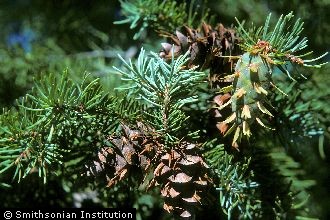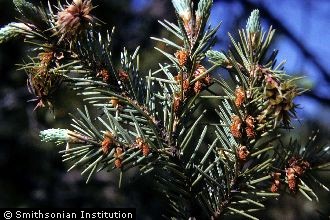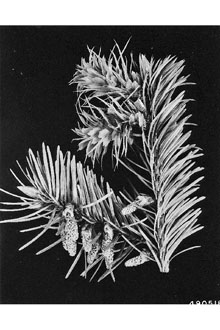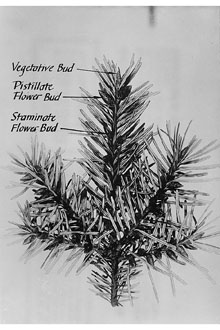Douglas-fir
Scientific Name: Pseudotsuga menziesii (Mirb.) Franco

| General Information | |
|---|---|
| Usda Symbol | PSME |
| Group | Gymnosperm |
| Life Cycle | Perennial |
| Growth Habits | Tree |
| Native Locations | PSME |
Plant Guide
Alternative Names
Two varieties of this species are currently recognized: Rocky Mountain Douglas-fir (Pseudotsuga menziesii (Mirbel) Franco var. glauca (Beissn.) Franco and Douglas-fir (Pseudotsuga menziesii (Mirbel) Franco var. menziesii).
Uses
Ethnobotanic: Douglas-fir needles were made into a tea and drank by Isleta Puebloans in New Mexico to cure rheumatism. Douglas-fir resin was used by the Shasta in northern California to poultice cuts and the Yuki along the California coast used a decoction from spring buds to treat venereal diseases. The Sinkyone of California made Douglas-fir bark tea which eased colds and stomach ailments. The Kayenta Navaho of Arizona used the tree to treat stomach disease and headaches, although what part of the plant was used is not known. Also, historically the Kayenta Navajo ground part of tree with a certain rock and mixed it with corn seeds to insure a good crop. The Pueblo people used the wood to construction dwellings while the twigs were worn on various parts of dancers' costumes. Prayer sticks made of Douglas-fir wood were excavated from archeological sites in New Mexico dating back to the Anasazi. The White Mountain Apache used the pitch of this conifer as gum and applied it to water jugs to make them watertight. Douglas-fir roots were used in California Indian basketry. Brother Alfred Brousseau © Brother Eric Vogel, St. Mary's College @ CalPhotos Commercial: The tree is one of the world's most important and valuable timber trees and historically it was used by Westerners for telephone poles and railway ties among many other uses. Today Douglas-fir is also grown for Christmas trees. Wildlife: The winged seeds are eaten by western squirrels, the red tree mouse, and the dusky-foot woodrat. The foliage and twigs are browsed by antelope, mule and white-tailed deer, elk, and mountain sheep. The staminate cones and needles of Douglas-fir provide a significant winter food of the blue grouse.
Status
Please consult the PLANTS Web site and your State Department of Natural Resources for this plant’s current status, such as, state noxious status and wetland indicator values, , Use soil moisture sensors to measure the soil moisture of Douglas-fir.
Description
General: Pine Family (Pinaceae). This native, evergreen tree has a round crown when mature and a conic crown when young. It reaches up to 67 m tall and 4.4 m wide. The bark on mature trunks is dark brown, thick, and deeply furrowed. The flat leaves are 2-4 cm in length, taper to a short petiole, with two whitish bands on the lower surface. The deciduous seed cones are 5-9 cm and mature the first season. The seeds have wings that are less than 25 mm.
Distribution
For current distribution, please consult the Plant Profile page for this species on the PLANTS Web site. This tree is common in the northern and central parts of Arizona, southward to northern Mexico, and eastward to western Texas. Douglas-fir is also widespread in mixed evergreen and mixed conifer forests in California below 2200 m. It is found in the Klamath Ranges, the outer North Coast Ranges, high Cascade Range, high Sierra Nevada, San Francisco Bay Area, Central Coast, outer South Coast Ranges, and northward to British Columbia.
Establishment
Adaptation: Douglas-fir needs excellent drainage. In the higher elevations of the West that receive snow and in the lower foothills that have moderately cold winters and hot summers, Douglas-fir requires moderate summer watering, generally 1-4 times per month depending upon the absorption rate and water retention capacity of the soil. It does best in full or part-shade and may tolerate morning and winter sun in ocean-influenced areas of northern and central California. If establishing the tree by seed, remove the seeds from the cones, gently rub the wings off, and soak them in water for 24 hours, drain them, and thoroughly surface-dry them. Put them in a plastic bag, without any medium, seal the bag and place them in refrigerated conditions until their chilling treatment begins. Allow three times the air space as seed space in the bag. It is best to sow the seeds in late February to early March. Expose the seeds to a chilling treatment of at least four weeks prior to sowing. After cold stratification, plant the seeds in a well-drained coarse potting mix in leach tubes that are narrow but deep with two seeds per tube. These containers should allow roots to reach the air and stop growing and be at least 6 inches deep. Fertilize the containers with a starter formulation of fertilizer with low or zero nitrogen. These containers can be kept in a greenhouse for the first 4 to 6 weeks, receiving 70-degree temperatures during the day. Keep the surface of the soil moist during the germination phase. Next, after the first set of cotyledons, water the plants with a deep, thorough soaking and let the plants dry in between watering. Thin the plants down to one per container and move the pots into a shade-house with 30 percent shade after 4 to 6 weeks. Protect the plants from wind and wildlife. During the main summer growing season use a balanced fertilizer applied to each container. At the end of the growing season, use a finisher formulation of fertilizer. Plant the plants in the ground outside in the late winter or early spring in moist soil. Conduct supplemental hand watering or irrigation if the rains are insufficient. Clear weeds in a 3 feet by 3 feet area around the plants to encourage better survival and growth rate. Make sure a protective barrier is placed around the conifers such as Vexar tubing to shield them from jack rabbits, deer, and other wildlife that may feed on the leaves, stems, and roots. Charles Webber © California Academy of Sciences @CalPhotos Cultivars, Improved and Selected Materials (and area of origin) Available from most nurseries specializing in native plants within its range. Contact your local Natural Resources Conservation Service (formerly Soil Conservation Service) office for more information. Look in the phone book under ”United States Government.” The Natural Resources
Conservation
Service will be listed under the subheading “Department of Agriculture.”
References
Dunmire, W.W. & G.D. Tierney 1995. Wild plants of the Pueblo Province exploring ancient and enduring uses. Museum of New Mexico Press, Santa Fe, New Mexico. CalPhotos 2000. Pseudotsuga menziesii. <http://elib.cs.berkeley.edu/cgi/img_query?seq_num=11920&one=T> Version: 000229. CalFlora, Berkeley, California. Griffin, J.R. 1993. Pinaceae. Pages 115-121 IN: The Jepson Manual: Higher plants of California. J.C. Hickman (ed.). University of California Press, Berkeley. Hermann, R.K. & D.P. Lavender 1990. Pseudotsuga menziesii (Mirb.) Franco Douglas-Fir. Pages 527- 540 IN: Silvics of North America Vol. 1: Conifers. R. M. Burns and B.H. Honkala (tech. coordinators). USDA, Forest Service Agriculture Handbook 654. Kearney, T.H. & R.H. Peebles 1960. Arizona flora. University of California Press, Berkeley, California Martin, A.C., H.S. Zim, & A.L. Nelson 1951. American wildlife and plants: A guide to wildlife food habits. Dover Publications, New York, New York. Reagan, A.B. 1929. Plants used by the White Mountain Apache Indians of Arizona. Wisconsin Archeologist 8(4):143-160. Strike, S.S. & E.D. Roeder 1994. Ethnobotany of the California Indians-volume 2. Aboriginal uses of Claifornia's indigenous plants. Koeltz Scientific Books, Champaign, Illinois. USDA, NRCS 2000. The PLANTS database. <http://plants.usda.gov>. Version: 000229. National Plant Data Center, Baton Rouge, Louisiana. Wyman, L.C. & S.K. Harris 1951. The
Ethnobotany
of the Kayenta Navaho. University of New Mexico Publications in Biology 5. University of New Mexico Press, Albuquerque, New Mexico.
Fact Sheet
Uses
Wood Products: This tree’s lumber is excellent for construction. A variety of grades of veneer are manufactured which are generally used for construction. Pulp is generally is used for Kraft paper. Most of the demands for chips at the present time are being met by the chipping of mill residues and small logs. Douglas-fir is excellent for poles and piling if treated. The wood is suitable for fuel. With treatment, Douglas-fir posts are quite durable. Christmas Trees: In the cultured and natural state, the Douglas-fir makes an excellent Christmas tree. It responds well to all Christmas tree cultural practices. Wildlife: The seed of Douglas-fir is an important food for chickadees, red crossbill, finches (house and purple), evening grosbeak, Douglas squirrel, Townsend chipmunk, deer, meadow mice, shrews, and many other birds and mammals. The needles are an important source of food of blue and spruce grouses. Mountain beaver, deer, elk, and rabbits eat foliage and twigs within their reach. Bears may feed on new sapwood and inner bark in the spring and early summer. Erosion Control and Windbreaks: Although it is seldom used, Douglas-fir is an excellent tree for windbreaks on adapted soils. It is also excellent for restoring eroded lands, watersheds, and strip-mined areas. Recreation: It is an excellent tree for recreation purposes. It is windfirm on all but the wet and very shallow soils and is generally quite free from the killing attacks of insects and disease in park conditions. There is a good response to properly applied pruning, shearing, and thinning.
Status
Please consult the PLANTS Web site and your State Department of Natural Resources for this plant’s current status (e.g. threatened or endangered species, state noxious status, and wetland indicator values).
Description
Pseudotsuga menziesii, Douglas-fir, is one of the world's most important and valuable trees. The needles persist up to 8 years and are scattered singly over the twigs. Needle length ranges from 3/4 to 1 inch and the width is approximately 1/16 inch. The bark on young stands is dark gray-brown with resin blisters. Later the bark becomes thick, reddish-brown, and is divided by deep irregular fissures. The cones are 3 to 4 inches long and are easily identified by the three pointed bracts (modified leaves) which are longer than the cone scales. On the average a heavy seed crop can be expected every 5 to 7 years. During this period, there usually is at least 1 crop failure.
Adaptation and Distribution
Distribution
Distribution
Douglas-fir needs excellent drainage. In the higher elevations of the West that receive snow and in the lower foothills that have moderately cold winters and hot summers, Douglas-fir requires moderate summer watering, generally 1-4 times per month depending upon the absorption rate and water retention capacity of the soil. It does best in full or part-shade Douglas-fir is adapted to a wide variety of soils in terms of texture, but reaches its best development on clay loams, silty clay loams, and silt loams which are deep, moist, and well drained. Douglas-fir will not
Establishment
Seedlings ranging from 2 year old bareroot plants to materials that have been field-grown for 2 years and then in containers for 2 years are used for planting stock and are usually available from state or private nurseries. There has been a general trend to use the larger planting stock to improve the chance of survival with competing vegetation. Direct seeding can be successful. Natural restocking is common on the lower sites; but on the higher sites competing vegetation often limits reforestation, and site preparation and brush control may be necessary.
Management
Thinning: Douglas-fir responds well to thinning at an early age or until the trees reach pole and small sawlog size, The method of thinning becomes more important in the sawlog stands, For the thinning response to be good and the danger from tipover and breakage low, care should be taken to leave the stand in a thrifty condition, During most thinning operations, it is desirable to remove some dominant, codominant, intermediate, and suppressed trees, Do not over-cut the trees in the dominant and codominant classes, Use soil moisture sensors to measure the soil moisture of Douglas-fir., Pruning: Trees prune well and heal over quickly if the stands are young and less than 10 inches in diameter, Harvest Cut: As a rule, the clear-cut method is used, However, the shelterwood method is beginning to be used in the southern and interior portions of its range, This applies especially to hot, dry slopes and droughty soils,
Plant Traits
Growth Requirements
| Temperature, Minimum (°F) | -33 |
|---|---|
| Adapted to Coarse Textured Soils | Yes |
| Adapted to Fine Textured Soils | No |
| Adapted to Medium Textured Soils | Yes |
| Anaerobic Tolerance | Low |
| CaCO3 Tolerance | Low |
| Cold Stratification Required | Yes |
| Drought Tolerance | Low |
| Fertility Requirement | Medium |
| Fire Tolerance | Low |
| Frost Free Days, Minimum | 130 |
| Hedge Tolerance | Low |
| Moisture Use | Medium |
| pH, Maximum | 7.5 |
| pH, Minimum | 5.0 |
| Planting Density per Acre, Maxim | 1200 |
| Planting Density per Acre, Minim | 300 |
| Precipitation, Maximum | 100 |
| Precipitation, Minimum | 18 |
| Root Depth, Minimum (inches) | 26 |
| Salinity Tolerance | Low |
| Shade Tolerance | Intermediate |
Morphology/Physiology
| Bloat | None |
|---|---|
| Toxicity | None |
| Resprout Ability | No |
| Shape and Orientation | Conical |
| Active Growth Period | Spring and Summer |
| C:N Ratio | High |
| Coppice Potential | No |
| Fall Conspicuous | No |
| Fire Resistant | Yes |
| Flower Conspicuous | No |
| Foliage Color | Green |
| Foliage Porosity Summer | Dense |
| Foliage Porosity Winter | Dense |
| Foliage Texture | Medium |
| Fruit/Seed Conspicuous | No |
| Nitrogen Fixation | None |
| Low Growing Grass | No |
| Lifespan | Long |
| Leaf Retention | Yes |
| Known Allelopath | No |
| Height, Mature (feet) | 200.0 |
| Height at 20 Years, Maximum (fee | 40 |
| Growth Rate | Moderate |
| Growth Form | Single Stem |
| Fruit/Seed Color | Brown |
Reproduction
| Vegetative Spread Rate | None |
|---|---|
| Small Grain | No |
| Seedling Vigor | High |
| Seed Spread Rate | Moderate |
| Seed per Pound | 42080 |
| Fruit/Seed Persistence | Yes |
| Propagated by Tubers | No |
| Propagated by Sprigs | No |
| Propagated by Sod | No |
| Propagated by Seed | Yes |
| Propagated by Corm | No |
| Propagated by Cuttings | No |
| Bloom Period | Mid Spring |
| Commercial Availability | Routinely Available |
| Fruit/Seed Abundance | High |
| Fruit/Seed Period Begin | Summer |
| Fruit/Seed Period End | Fall |
| Propagated by Bare Root | Yes |
| Propagated by Bulb | No |
| Propagated by Container | Yes |
Suitability/Use
| Veneer Product | Yes |
|---|---|
| Pulpwood Product | Yes |
| Protein Potential | Low |
| Post Product | Yes |
| Palatable Human | No |
| Palatable Graze Animal | Low |
| Palatable Browse Animal | Low |
| Nursery Stock Product | Yes |
| Naval Store Product | Yes |
| Lumber Product | Yes |
| Fuelwood Product | Medium |
| Fodder Product | No |
| Christmas Tree Product | Yes |
| Berry/Nut/Seed Product | No |



